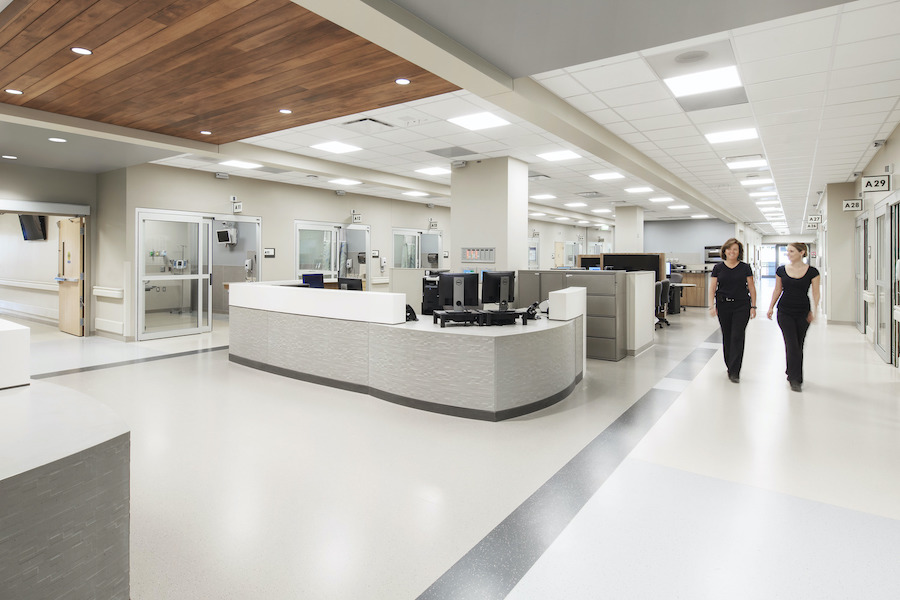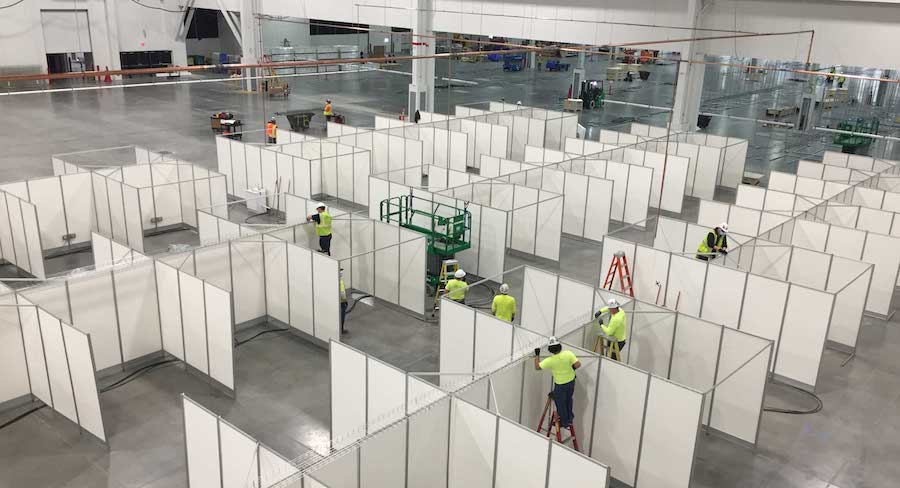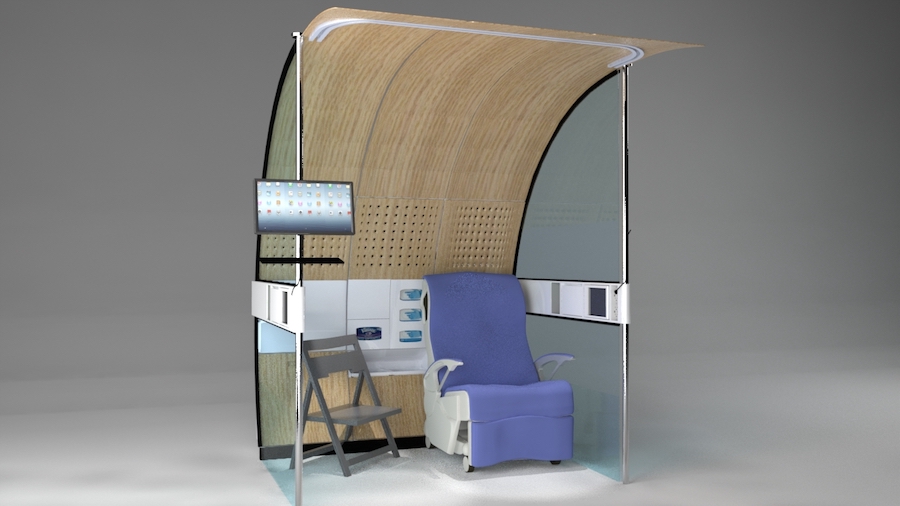Healthcare / Service redesign
Comment
Expect the unexpected: planning an alternative ‘surge’ healthcare system
02 Jul 2020 | 0
Three leading US architects, Ronald L Skaggs, Joseph G Sprague and George J Mann, consider what measures are needed to create a robust global health system that can protect people from unexpected health events.
Our planet has suffered a tremendous unprecedented shock that has rocked the very foundations of society. Plain and simple, we’ve been attacked by a virulent deadly disease. How can we defend ourselves against the unexpected? What have we learned and how do we recover? What do we need to do? What can we do?
Just as after the Pearl Harbor and World Trade Center attacks, people have had to change and adapt quickly. This pandemic’s long-range effect on the planet’s population will be profound. The mortality rate has mushroomed, and the crisis will have a very negative impact on the global economy. It caught us all off guard and was totally unexpected.
New planning, design and construction programme
We will need a new alternative ‘surge’ health facilities programme, similar to the Hill Burton Construction programme (US federal law passed in 1946), for planning, design, construction, operation and maintenance of appropriate health facilities to handle mass casualties or mass communicable disease events. 
In addition, sheltering-in-place orders need to be followed in a pandemic, or an entire population could be placed at risk.
Leading the defence
An outbreak of disease anywhere is an outbreak everywhere. We have developed a global economy, corporations, communications, universities, airlines, military, global thinking – but not true global health. How can these other global initiatives work without global health? They cannot.
We need an integrated interdisciplinary alternative approach so that we can be properly prepared for all possible natural disasters – tornados, tsunamis, cyclones, hurricanes, typhoons, floods, fires, pandemics. We need to be prepared for all possible shocks, both biological and manmade incidents, including radioactive incidents, military attacks, bioterrorism warfare, and any other conceivable threats.
COVID-19 does not respect national boundaries. That means we have to approach solving this problem co-operatively. If we do not succeed in this, the loss of life could be horrific. Governmental agencies, private corporations and international organisations will have no choice but to co-operate in good faith. The squabbling between countries must stop so we can solve the world’s major problems.
Clarity and continuity in decision making
We need a strengthened administrative structure that can quickly recognise and then legally organise a response to all kinds of unexpected disasters. To a great extent, our planet was in denial when the pandemic got underway. Plain and simple, this event was outside the frame of reference and experience of most people. But the results are here to stay with us.
We need to further develop community emergency plans that connect with state and federal agencies that are prepared for any possible scenario.
In 2004, Dr P K Carlton MD, former surgeon-general of the United States Air Force, proposed the concept of “surge” hospitals to Texas A&M University’s College of Architecture, and he initiated a collaborative exploratory research and design project that explored what a surge hospital should look like. We give credit to his great humanitarian vision. Seventeen teams of students presented their architectural ideas for surge hospitals to Dr Richard Carmona, then surgeon-general of the United States, in December 2004, at Texas A&M University. He in turn presented these new architectural design concepts to Congress, but it never came to new legislation.
Today, we need an alternative system of health and hospital facilities that can handle sudden surges of patients in disasters, epidemics or other unforeseen events. Such surge facilities need to be organised in every community. Many existing buildings could quickly become surge facilities, including hotels, motels, stores, high school gymnasiums, warehouses, churches, convention centres, and other buildings.
However, buildings alone cannot save lives or heal. They need to have qualified medical, nursing and allied health staff prepared with beds, blankets, linens, food, water, medicine and medical supplies, caps, masks, gowns, ventilators, emergency power, and security. Infection control is a key concept and can help lower the death rate.
More research and development need to be done on special protective masks and clothing that caregivers must wear. We cannot risk losing vital health professionals to the extreme demands on them, both physically and emotionally, because without healthy health professionals “we are all dead in the water”.
It’s also important that we don’t bring patients with known highly infectious communicable diseases into a hospital, as this could bring down an entire hospital, and affect many patients, staff and families.
Developing a plan
Legal agreements with hotels, motels, convention centres, sports arenas, high schools and community centres need to be reached ahead of time, so that flipping them into surge hospital facilities can be accomplished quickly and seamlessly.
 Surge health and hospital facilities will also need to be staffed. Staff could be organised as a surge health auxiliary and include groups such as physicians, nurses, and other allied professionals like qualified retired staff, so the existing health and hospital facilities are not overwhelmed and/or contaminated. We watched as medical staff faced a deluge of cases and too many contracted COVID-19. One doctor in New York City who contracted COVID-19 committed suicide after he had recovered.
Surge health and hospital facilities will also need to be staffed. Staff could be organised as a surge health auxiliary and include groups such as physicians, nurses, and other allied professionals like qualified retired staff, so the existing health and hospital facilities are not overwhelmed and/or contaminated. We watched as medical staff faced a deluge of cases and too many contracted COVID-19. One doctor in New York City who contracted COVID-19 committed suicide after he had recovered.
Planning for such unexpected events must begin at a grassroots level, but it must also be co-ordinated with regional and statewide planning, neighbouring states and other countries.
Guidelines
We will need to develop new guidelines for surge health and hospital facilities. This effort needs to be co-ordinated with experienced groups, such as international agencies, organisations, agencies, as well as universities and architectural and engineering firms.
Ventilation and air exchanges
One of the most important areas to focus on, in both existing health facilities and proposed surge health facilities, relates to fresh air circulation and exchanges, so that the virus is not spread throughout a health facility, thus contaminating it. Experienced mechanical engineers who understand healthy airflow are vital to the success of the team. Below are some strategies by Nate Echtenkamp and Emily Waldenmeyer, professional engineers at the Beck Group, on reducing the spread of airborne pathogens:
- upgrade mechanical filters to Merv (Minimum Efficiency Reporting Value) 13 or higher;
- use bi-polar ionisation to eliminate airborne pathogens in the air and space;
- consider ultraviolet germicidal irradiation to inactivate airborne viruses;
- improve ventilation with higher flow rates to dilute pathogens; and
- maintain at least 40-per-cent relative humidity to minimise the time pathogens are airborne.

Use of technology and telemedicine
The experience of not having enough ventilators on hand must be addressed, while the pandemic has also shown the importance of telemedicine in patient care, whether in a densely populated area or in a remote setting. Mass testing for COVID-19 must also be rolled out quickly, and new technology can help in this regard. Perhaps mobile phones or smart watches could be developed further to detect when one is near a person who is infected.
Establish an interdisciplinary surge health and hospital facilities task force
An interdisciplinary task force should be assembled to undertake further development of the surge health and hospital concept. It should consist of representative international, national and regional agencies and organisations collaborating and co-operating.
Conclusions
What is proposed in this position paper needs to happen as quickly as possible, as we are woefully unprepared for future pandemic spikes and second waves, as well as other potential disasters. We owe this to our children and grandchildren.
We have spent billions of dollars on developing defence systems to prevent future Pearl Harbor and World Trade Center events. We now need to rethink the defence and health of all people in the context of new threats, and invest accordingly.
About the authors
Ronald L Skaggs FAIA, FACHA, FHFI, LEED AP is chairman emeritus at HKS. He is an adjunct professor of architecture at Texas A&M University, and donor of the Ronald L and Sondra Skaggs Endowed Professor in Health Facilities Design, the Skaggs-Sprague Endowed Chair in Health Facilities Design, and numerous other scholarships and awards.
Joseph G Sprague FAIA, FACHA, FHFI is a former principal and senior vice-president of HKS Inc, as well as past president of the Facility Guidelines Institute, the American College of Healthcare Architects and the AIA Academy of Architecture for Health.
George J Mann, Architect AIA is The Ronald L Skaggs Endowed Professor of Health Facilities Design at the College of Architecture, Texas A&M University. Founder and advisory board chairman of the Resource Planning & Development Group, he is former director of the UIA – PHG (International Union of Architects’ Public Health Group).
Brian Briscoe AIA, ACHA, EDAC, LEED AP BD+C supplied the imagery. A project manager and board-certified healthcare architect, Brian is also a vice-president at HKS.
Ronald, Joseph and George have been working together since the 1960s and have undertaken numerous research and architectural design projects all over the world. They have also authored and co-authored numerous publications together.
Organisations involved

